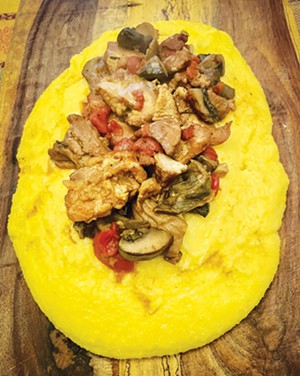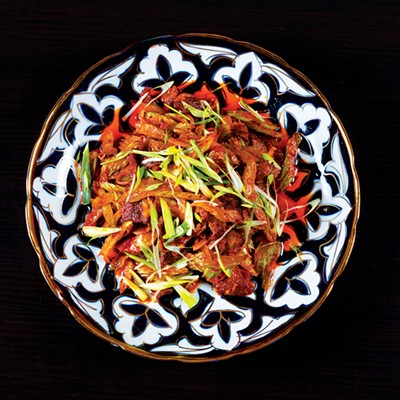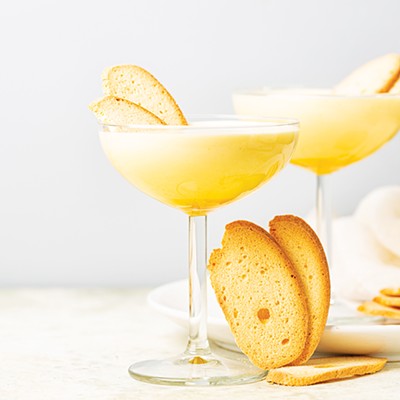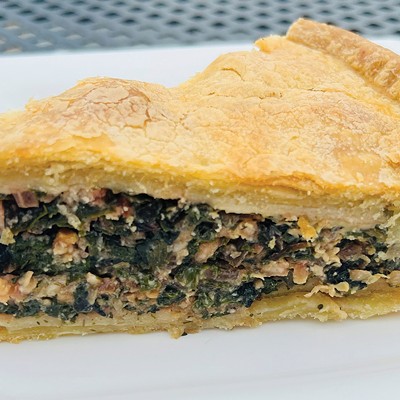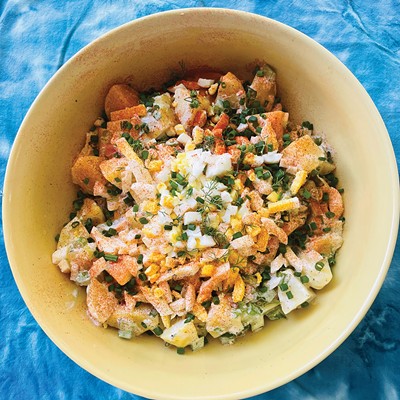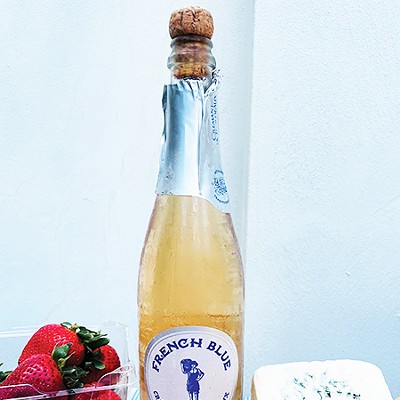Polenta, a type of cornmeal porridge or mush, is a humble peasant dish from northern Italy that predates the Roman Empire. Before Christopher Columbus introduced corn from the Americas to Europe, polenta was made from ground barley, fava beans, spelt, rye or buckwheat. Modern-day polenta is typically made from medium to coarsely ground yellow flint corn. Flint corn has a hard outer layer and soft interior that holds its shape when cooked, resulting in an al dente texture. Polenta has a mild corn taste and can soak up flavors from cooking liquids such as milk or stock.
The term "polenta" refers to both the Italian cornmeal product and the cooked dish. Though technically not "authentic," if you can't find the product labeled as "polenta," you can use any kind of medium or coarsely ground corn, even grits. Unlike Italian polenta, which is made from flint corn, grits are made from a different variety known as dent corn, which tends to cook up creamier rather than the more toothsome polenta. Also available in stores are finely ground, faster-cooking "instant polenta," and shrink-wrapped, precooked polenta that looks like a chubby sausage, though these versions are inferior in flavor and texture. As always, the quality of the finished dish reflects the quality of the ingredients used.
Polenta is a good source of protein and fiber, and compared to rice, pasta or potatoes, it is much lower in calories and fat. For people with celiac disease or gluten intolerance, polenta is a great substitute for wheat-based pasta and noodles. Though polenta is inherently gluten-free, it is important to check the product label to make sure it is processed and packaged in a dedicated gluten-free facility and not cross-contaminated with other wheat products. To designate a product as "gluten-free" in the U.S., it must contain less than 20 parts per million of gluten in the total product. That means for every million grains, there must be less than 20 gluten-containing grains.
In Italy, creamy polenta is often served family-style from a large wooden platter, allowing guests to serve themselves at the table. It can be topped simply with butter and cheese, or used as a base for ragùs, braised meats, sautéed mushrooms or pasta sauce. Cooked polenta can also be spread out on a sheet tray, firmed up in the refrigerator, cut into smaller pieces and fried. Polenta is truly slow food. It takes time to cook and requires some patience, but the process is simple. First, you bring a pot of salted water to a boil. Once the water is boiling, you add the polenta in a slow, steady stream, whisking constantly to prevent lumps. Then lower the heat and simmer for 30 to 50 minutes, stirring and scraping the bottom of the pot about every five minutes or so. The polenta should be thick and creamy when it's done.
In between stirring the polenta, you can grate cheese and finish up your toppings. Once the polenta is done cooking, you can serve it immediately or let it cool down for later. If preparing ahead of time, don't add the cheese until just before serving. The polenta will thicken or firm up as it cools, so you might need to thin it down with a little water when reheating.
Creamy Polenta
Serves 4-6
Put on some music and pour yourself a glass of wine, because you'll be hanging out by your stove for at least a half an hour. Any leftover creamy polenta can be refrigerated or frozen and used to make fried polenta.
Ingredients:
4 cups water, milk or chicken stock or vegetable stock (see note below)
1 cup polenta, not instant
1 teaspoon kosher salt
2 tablespoons unsalted butter (or if vegan: extra-virgin olive oil)
1 cup shredded parmesan (optional)
Notes:
Water produces the lightest polenta, with a mild corn flavor. Milk produces a heavier, but rich and creamy polenta. Stock infuses the polenta with more flavor but masks the flavor of the corn. You can split the difference and use half water and half milk, or half water and half stock.
Preparation:
In a large saucepan, add water, milk or stock, and set over high heat. Slowly pour in the polenta while whisking continuously to avoid lumps and bring to a boil. Continue whisking and when the polenta starts to thicken, after about five minutes, lower the heat until it stops bubbling.
When the polenta is too thick to whisk, switch to a wooden spoon or silicone spatula. Cover the pan, but every five minutes, stir and scrape the bottom to prevent scorching. When the polenta pulls away from the side of the pan and thickens to the texture of soft scrambled eggs, remove from the heat. This may take anywhere from 30 to 50 minutes.
Stir in butter or olive oil, and season with the salt. Keep warm until ready to serve. If the polenta becomes too firm, whisk in a small amount of water. Just before serving, stir in the shredded parmesan, if using.
Fried Polenta
Serves 4
Top with marinara sauce, sautéed mushrooms, or swap out for the English muffin in eggs Benedict.
Ingredients:
One recipe of Creamy Polenta (see above)
Canola, avocado, or grapeseed oil
Preparation:
Lightly grease a rimmed quarter sheet pan or 10-inch round cake pan with oil. Pour hot polenta into the pan and spread evenly with a spatula. Press parchment or plastic wrap against the surface and trim the excess. Wrap the whole pan with plastic wrap, and refrigerate until cold and firm, at least two hours overnight.
When ready to cook: Preheat the oven to 200 degrees. Run a thin spatula or knife around the perimeter of the chilled polenta and invert it onto a cutting board. Cut into squares, rectangles, triangles, fries or use a biscuit cutter to cut into circles. Warm a large nonstick or cast-iron skillet over high heat and coat with two tablespoons of oil. When the oil starts to shimmer, add the polenta pieces in batches; do not crowd the pan.
They should sizzle as soon as they hit the oil. Cook without moving until the polenta is browned, crisp and easily released from the skillet, about three minutes. With a thin-edged spatula, turn over and repeat on the second side. Drain on paper towels. Transfer the fried polenta pieces to a sheet tray with a cooling rack and place in the oven to keep warm. The fried polenta should remain crispy for up to 20 minutes.

